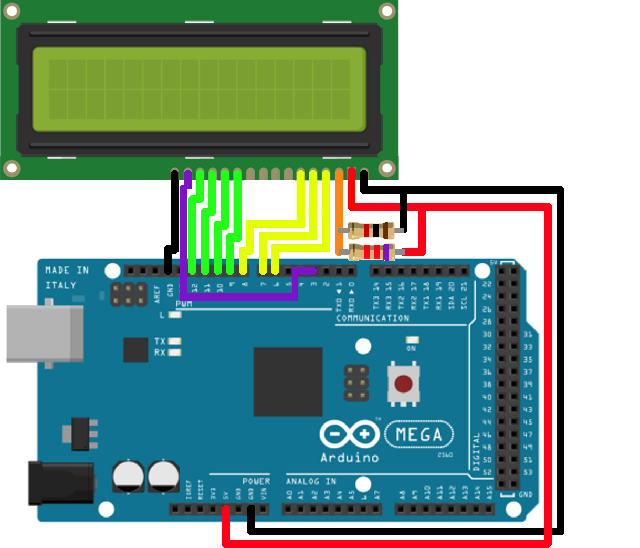

- #Coding lcd arduino how to
- #Coding lcd arduino serial
- #Coding lcd arduino code
- #Coding lcd arduino plus
There are numerous manufacturers of LCD keypad shields that have the same or similar pin connections, and you must ensure that the sample menu code uses the pin connections that are right for your shield. To keep things simple, all coding examples have been targeted to work with an R3 Arduino Uno/ Leonardo/ Mega2560, and an LCD keypad shield similar to one illustrated above. With our Arduino menu library, this independence is achieved by having the menu manager code use callback methods for handling user input and rendering the menu display. This is because there are many input and display devices available, and a generic menu system must be independent of whichever input and display devices you wish to use. If you have tried writing menu code for your Arduino projects, you will recognise the challenge in developing a generic menu system for an open prototyping platform. If this tutorial helped you in some way, do send me a message via the contact page.You may have used an electronic device with a small Liquid Crystal Display (LCD) which has a textual hierarchical menu system for setting device configuration parameters. See my separate post on Arduino I2C LCD for more! Turn on the blacklight and print a message. Set the LCD address to 0x27 for a 16 chars and 2 line display
#Coding lcd arduino serial
While (!Serial) // wait for serial monitor Here's a sketch that scans I2C devices that is connected to an Arduino: #include To use this module, we first need to know its I2C address. With this module, you will only need four pins! Here's how you should connect it to your Arduino: If you're having problems with the number of pins used for the LCD, then this solution might be for you: use I2C! There exists a module that accepts I2C data and converts them to parallel data that is understandable by the 16x2 LCD.

Here’s the list of all Arduino LCD functions. Similarly, the lcd.cursor() and lcd.noCursor() turns on and off the cursor. The lcd.Display() and lcd.noDisplay() turns on and off the LCD respectively. Other useful commands, not shown in the example are: lcd.Display() For a 16 x 2 LCD, x is from 0 to 15 while y is 0 to 1. Where x is the horizontal position and y is the vertical position. To move the cursor, you can use the command: lcd.setCursor(x,y) To write a message on the LCD, you use the command: lcd.write(“hello, world!”) 16 is the number of columns and 2 is the number of rows. Next, you need to specify the screen size of the LCD. You don’t also need to set the pinModes of these pins as they are automatically configured. This means you can actually assign which pins you can use with the LCD pins. Initializes the lcd object followed by the Arduino pin numbers assigned to RS, E, D4 to D7 respectively. Without this line, we can’t use the functions associated with LCD control.


The most important part is the inclusion of the LiquidCrystal library. Upload the code to your Arduino and you should see the display “hello, world!” on the first line and a number counting every second in the second line. The schematic shown above follows that same connection. Those comments are important for beginners as it includes the connection between the LCD and the Arduino. Note that I purposely removed the comments above this code. print the number of seconds since reset: (note: line 1 is the second row, since counting begins with 0): set up the LCD's number of columns and rows: initialize the library with the numbers of the interface pins You should be seeing this code: // include the library code: Open the Arduino IDE, then go to File > Examples > LiquidCrystal > HelloWorld. We’ll be using the example sketch “HelloWorld” from Arduino’s built-in LiquidCrystal library. Now let's start coding! Simple Arduino LCD Code
#Coding lcd arduino plus
So that leaves six Arduino pins to be used with this LCD plus the VDD and A (+3.3V or +5V) and VSS and K(GND) pins. The R/W pin is almost always connected to ground since R/W = 0 is writing to the LCD and R/W = 1 is reading to the LCD (which doesn't happen very often). Thankfully, this LCD has a four-bit mode which means you don't have to use all 8 data pins. That's a lot of pins to connect to an Arduino. The LCD's parallel interface makes it faster than I2C and SPI LCD's but the trade off is you need a lot more wires. The widely used 16 x 2 character LCD uses the HD44780 controller from Hitachi which has been around since 1987.
#Coding lcd arduino how to
In this Arduino LCD tutorial, you will learn how to display characters (text and numbers) on a 16 x 2 LCD which is very useful in debugging microcontroller projects as well as providing text-based status for your systems.


 0 kommentar(er)
0 kommentar(er)
